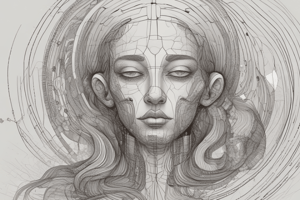Podcast
Questions and Answers
What is the process through which culture is passed on from one generation to the next?
What is the process through which culture is passed on from one generation to the next?
- Socialization (correct)
- Immigration
- Globalization
- Education
What is the philosophy of art that helps us judge and understand it?
What is the philosophy of art that helps us judge and understand it?
- Socialization
- Aesthetics (correct)
- Immigration
- Globalization
What type of art is appreciated for its beauty and communication of feelings and ideas?
What type of art is appreciated for its beauty and communication of feelings and ideas?
- Applied arts
- Fine arts (correct)
- Mediaeval art
- Romanesque art
What is the purpose of art?
What is the purpose of art?
Which of the following is not part of culture?
Which of the following is not part of culture?
What is the key purpose of art?
What is the key purpose of art?
What is the process that begins from birth and continues throughout our lives?
What is the process that begins from birth and continues throughout our lives?
What type of art has both form and function?
What type of art has both form and function?
What is the relationship between art and morality?
What is the relationship between art and morality?
What is the history of art and its relationship to morality?
What is the history of art and its relationship to morality?
Flashcards are hidden until you start studying
Study Notes
- Culture includes all aspects of human thought, feeling and way of life.
- Culture is passed on from one generation through the next by the process of socialization which is a process that begins from birth and continues throughout our lives as we aquire a personal identity, learn the norms, values and appropriate behaviour to function within our society.
- There is an ongoing refinement of culture, societies are now becoming multi-cultural showing that there is strong influence of different cultures through the media, immigration and globalization.
- Art along with other areas such as science, religion and politics forms part of culture.
- We can define art as the expression or application of human creative skill and imagination through works such as paintings, music and sculptures, to be appreciated for the beauty or emotional power.
- Aesthetics is the philosophy of art- it helps us judge art and understand it:
- The artist's expression, the time period when it was painted, and the culture of the artist are the three contexts in which art must be placed.
- Fine arts are appreciated for their beauty and communication of feelings and ideas. They have no practical function beyond the aesthetic experience. These include paintings, sculptures and drawings.
- Applied arts have both form and function as they can be attractive and useful. These include graphic design, fashion and bookmaking.
- Values are also an integral part of culture. They can be defined as beliefs or principles that one finds of importance as guidelines.
- The history of art and its relationship to morality dates back to antiquity and has continued to be a subject of interest and debate throughout the centuries.
- European art was often created with the intention of teaching and promoting moral values, with the work of art serving as a medium for communication between the artist's intentions and the viewer.
- During the mediaeval period, art had a greater morality function in that it was used to teach the largely illiterate population to change their values and beliefs.
- Some artists during the Romanesque period chose to depict the negative aspects of human behaviour, such as the Last Judgement.
- However, the key purpose of art has always been to communicate values and morals to the viewer, with the power of art to influence and change behaviour being a long-standing tradition.
Studying That Suits You
Use AI to generate personalized quizzes and flashcards to suit your learning preferences.




